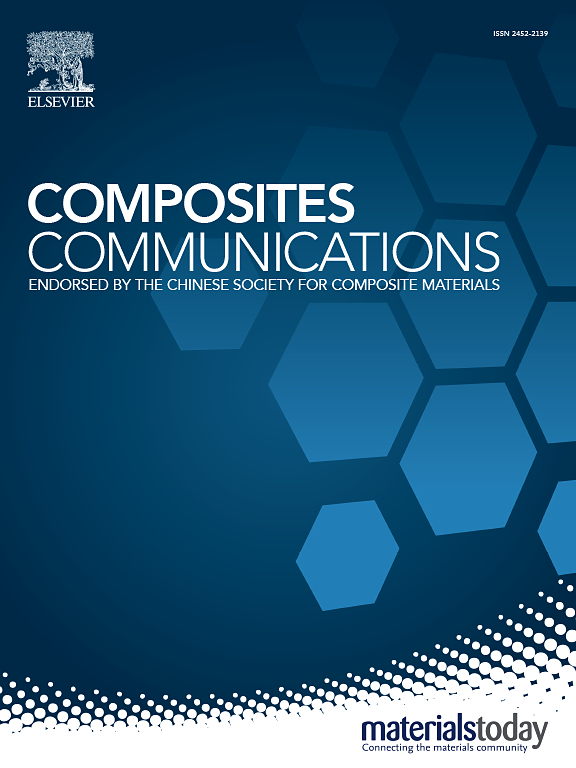富氮空位碳球/g-C3N4 复合材料上的高效光催化二氧化碳和六价铬还原作用
IF 7.7
2区 材料科学
Q1 MATERIALS SCIENCE, COMPOSITES
引用次数: 0
摘要
本研究采用水热法制备了碳球(CS)/g-C3N4 复合材料,表征结果表明,在合成过程中,CS 成功锚定在 g-C3N4 表面,并构建了丰富的氮空位。所有这些有利因素都增强了 g-C3N4 的光催化二氧化碳还原活性。CS 与 g-C3N4 之间紧密的界面相互作用赋予了光催化剂更大的比表面积、更高的光利用效率和更强的光诱导电荷分离能力。此外,氮空位的存在进一步加快了光生电荷的分离和迁移效率,为促进 CO2 分子的吸附和活化提供了额外的活性位点,从而有效提高了光催化还原 CO2 的活性。CS/g-C3N4 复合材料上的二氧化碳转化率高于参考 g-C3N4。在三种不同的单色光照射下,表观量子产率(AQY)也优于参考 g-C3N4。通过循环实验验证了该催化剂的稳定性,表明其具有良好的实际工业应用潜力。利用原位漫反射红外傅立叶变换光谱(DRIFTS)阐明了二氧化碳还原机理和转化途径。50CS/CN 对 Cr(VI) 的光催化还原速率常数是 CN 的 2.9 倍。该研究介绍了一种合成 g-C3N4 基光催化材料的简便方法,为提高 g-C3N4 光催化 CO2 和 Cr(VI) 还原的光催化活性提供了一种有趣的策略。本文章由计算机程序翻译,如有差异,请以英文原文为准。
Efficient photocatalytic CO2 and Cr(VI) reduction on carbon spheres/g-C3N4 composites with enriched nitrogen vacancies
In this study, carbon spheres (CS)/g-C3N4 composite materials were fabricated by a hydrothermal method, and the characterizations have confirmed the successful anchoring of CS onto the surface of g-C3N4, constructing enriched nitrogen vacancies during the synthesis process. The photocatalytic CO2 reduction activity of g-C3N4 is enhanced by all of these advantageous factors. The significant enhancement can be attributed to the tight interfacial interaction between CS and g-C3N4, which endows with the photocatalyst a larger specific surface area, higher light utilization efficiency and stronger capability for photoinduced charges separation. Furthermore, the presence of nitrogen vacancies further accelerates the separation and migration efficiency of photogenerated charges, provides additional active sites to promote the adsorption and activation of CO2 molecules, thereby effectively boosting the photocatalytic activity for CO2 reduction. The CO2 conversion rate on CS/g-C3N4 composite materials is higher than that on the reference g-C3N4. The apparent quantum yield (AQY) is also superior to that of the reference g-C3N4 under three different monochromatic light irradiations. The stability of the catalyst was verified through cycling experiments, indicating promising potential practical industrial application. The CO2 reduction mechanism and transformation pathways were elucidated using in-situ diffuse reflectance infrared Fourier transform spectroscopy (DRIFTS). The photocatalytic reduction rate constant of Cr(VI) by 50CS/CN is 2.9 times higher than that by CN. This study introduces a facile approach for synthesizing g-C3N4-based photocatalytic materials, providing an interesting strategy to boost photocatalytic activity of g-C3N4 for photocatalytic CO2 and Cr(VI) reduction.
求助全文
通过发布文献求助,成功后即可免费获取论文全文。
去求助
来源期刊

Composites Communications
Materials Science-Ceramics and Composites
CiteScore
12.10
自引率
10.00%
发文量
340
审稿时长
36 days
期刊介绍:
Composites Communications (Compos. Commun.) is a peer-reviewed journal publishing short communications and letters on the latest advances in composites science and technology. With a rapid review and publication process, its goal is to disseminate new knowledge promptly within the composites community. The journal welcomes manuscripts presenting creative concepts and new findings in design, state-of-the-art approaches in processing, synthesis, characterization, and mechanics modeling. In addition to traditional fiber-/particulate-reinforced engineering composites, it encourages submissions on composites with exceptional physical, mechanical, and fracture properties, as well as those with unique functions and significant application potential. This includes biomimetic and bio-inspired composites for biomedical applications, functional nano-composites for thermal management and energy applications, and composites designed for extreme service environments.
 求助内容:
求助内容: 应助结果提醒方式:
应助结果提醒方式:


